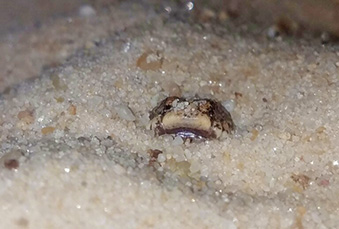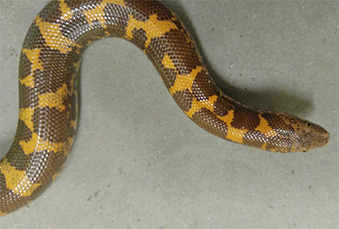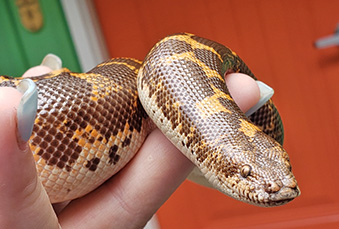Gongylophis colubrinus | Kenyan/Egyptian Sand Boa
Name: Tambi (Female)



Meet Tambi, Our Sandy Specialist
Patience is a virtue… especially if you’re a Kenyan Sand Boa like Tambi—whose name means noodle in Swahili. With her smooth, muscular, tube-shaped body and slow, deliberate movements, Tambi is the definition of stealth. She’s a prime example of a snake built not for speed, but for the art of ambush.
Tambi was hatched in November 2013 and now serves as an Ambassador Animal, helping to educate about the unique adaptations of burrowing reptiles—and why exotic animals, no matter how small, don’t belong in homes as pets.
Life in the Sand
Native to the semi-deserts and scrub savannas of Northern and Eastern Africa, the Kenyan Sand Boa is a master of concealment. This species spends nearly all its time buried beneath loose soil or sand, with only its eyes and nostrils visible above the surface. Their heads are small and wedge-shaped, with upward-facing features designed specifically for peeking just above the ground without being seen.
This body plan is no accident. Sand boas are short and stout—averaging just 2 to 3 feet in length—and lack the narrow neck seen in other species like ball pythons. Instead, their muscular, noodle-like body allows them to burrow effortlessly through sand, disappearing in seconds.
Constrictor in Disguise
Tambi may not chase her prey but make no mistake—she’s a skilled hunter. Sand boas are ambush predators, lying in wait under the sand until the perfect moment. When a small rodent or lizard passes by, Tambi lunges upward, grabbing the prey with her backward-facing teeth and quickly wrapping her body around it in a tight constriction.
Once subdued, the prey is dragged under the sand and swallowed whole—a process that’s fascinating and a bit eerie!
Snakes don’t chew their food. Instead, their lower jawbones are connected by stretchy ligaments and can move independently, allowing them to “walk” their meal into their throat. They can open their mouths wider than their bodies—thanks to this unique jaw structure—and they’re able to breathe the whole time using a special tube called a glottis, which stays open near the front of the mouth during feeding.
A Master of Survival
Tambi’s patience extends beyond hunting. In the wild, Kenyan Sand Boas can go up to a year without eating, a testament to their remarkable ability to store energy and survive harsh conditions.
Here are a few more cool survival tricks:
- Small size = better temperature regulation in extreme environments.
- Light coloration helps blend into the sand and hide from predators and prey alike, this is called camouflage.
- Burrowing behavior keeps them cool in the day, insulated at night, and hydrated underground.
- When threatened, they deliver surprising tail whips using their spiked, thick tail—a last-resort defense mechanism.
Life at the Zoo
Tambi is fed a diet of frozen/thawed mice, which closely mirrors the small mammals and invertebrates just like her wild counterparts. While she lives behind the scenes, she plays an important role in our zoo’s education and outreach programs as an Ambassador Animal.
Tambi was chosen for this role not only because of her fascinating adaptations, but because she is an excellent example of why exotic animals like snakes should not be kept as pets. Even small species like the Kenyan Sand Boa have very specific needs that are difficult to meet in a home setting.
If you're considering adding a Kenyan Sand Boa to your family, do your research to ensure you can meet their needs. They require significant time, effort, and financial investment—there are no shortcuts when it comes to responsible reptile care!
If you would like to learn more about why domestic animals are the best pets for most people, check out the Not-a-Pet campaign! And remember, if you have the knowledge and means to add a snake to your family, adopt don’t shop! There are tons of reptiles out there waiting for the right person to care for them.
Fact Sheet
Taxonomy
Species: Gongylophis colubrinus
Kingdom: Animalia | Phylum: Chordata | Class: Reptilia | Order: Squamata | Family: Boidae | Genus: Gongylophis |
Favorite Enrichment Type
Tambi loves mirrors, her Holey Roller (rubber ball with holes in it), ball pit balls/things buried in her substrate, and paper bags to slither in!
Life Span
- In the Wild: 10 to 15 years
- In Human Care: 20 to 30+ years
Diet
- In the Wild: Small mammals and invertebrates
- At the Zoo: Small frozen/thawed mice
Geographic Range
Northern and Eastern Africa
Habitat
Semi-desert and scrub savannas
Fast Facts About Kenyan Sand Boas
- Size: Only 2–3 feet long—perfect for squeezing through loose soil.
- Heat adaptations: Built for extreme heat, with their light color, small size, and ability to burrow under the sand to stay cool.
- NOT venomous: Constricts prey and swallows it whole with specialized jaws.
- Desert fasting adaptation: Can go up to a year without eating.
- Teeth: Has backward-facing teeth and a movable jaw for eating prey.
- Swallowing prey whole: Can “breathe while eating” using a glottis.
- Defense: Uses a spiky tail whip when cornered.
Status: Least Concern
International Union for Conservation of Nature (IUCN) — Least Concern
How to Find Me
Tambi is a member of our Ambassador Animals that live behind the scenes! If you would like to meet Tambi in person, check out our daily, 11:00am Amphitheater Presentations at the Awareness Amphitheater, located just beyond the covered bridge. Amphitheater Presentations are dependent on the weather. Please check our activity board, behind the Admissions booth, before coming to see us!
